
Art in Conversation With Farrin


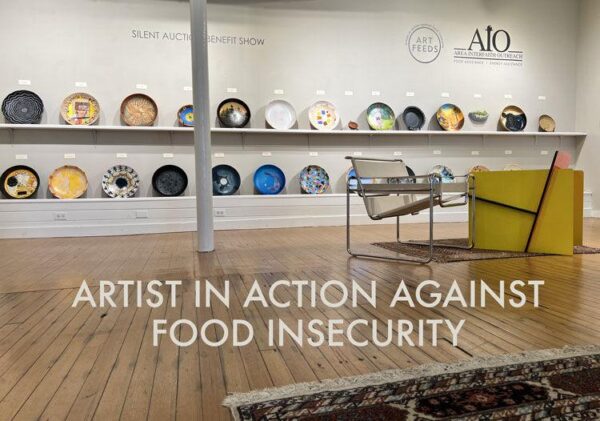
The Courier-Gazette
knox.villagesoup.com
August 22, 2023
CAMDEN/ROCKLAND — AIO Food & Energy Assistance announces the opening of the 2nd Annual ArtFeeds exhibition and online silent auction, taking place Sept. 10 through 16 at Page Gallery, 23 Bayview St., Camden. The event will showcase a collection of wooden bowls shaped and donated by Maine State Correctional Facility’s industries program, and decorated by well-known Maine artists. Each artist interprets sharing food and fighting food insecurity in their creative style on each bowl.
The online silent auction also opens Sept. 10 and runs the length of the exhibition, culminating with a reception Saturday, Sept. 16, from 4 to 6 p.m. at Page Gallery. The exhibition is free and open to the public.
“ArtFeeds represents an entire summer of artists, volunteers, partnering organizations and supporters working together to demonstrate how a community can address hunger,” said AIO Executive Director Joe Ryan. “For the winning bidders, an ArtFeeds bowl will be a family treasure for generations to come, and the benefit to hundreds of local families will be immediate.”
“At Page Gallery, we are happy to be partnering with AIO and the Maine State Prison to raise awareness about food and energy insecurity,” said gallery owner Colin Page. “Artists jump at the chance to work on new pieces for this auction as we all know how important AIO is to our community. When the bowls are on display at Page Gallery, you can see how much creativity and beauty is brought to the table by the selected artists.” Page went on to say, “As a gallery owner I love using our space to give back, and as an artist I find it a rewarding and interesting challenge to paint across the form of a bowl, and to consider how my artwork can be used to benefit others.”
Participating artists include Alan Magee, Annie Bailey, Barbara Sullivan, Beth Bull, Caroline Dishop, Christopher Mur, Colin Page, Carol Sloane, Hannah Berta, Helene Ferra, Eric Hopkins, Ileana Appleton Foster, Ingrid Ellison, Laura Waller, Leecia Price, Lise Bécu, Margaret Rizzio, Meghan Brady, Monica Kelly, Nancy Glassman, Nathaniel Meyer, Peter Walls, Sal Taylor Kidd, Sarah Lee, Simon van der Ven, Susan Williams, Tara Morin, Alanna Hernandez, Alexis Iammarino, Anneli Skaar, Greta Van Campen, Amy Lowry, Ariela Kuh, Lily Sukeforth, Margaret Williams, Richard Chalmers, and a resident of the Maine State Correctional Facility. AIO will share the artists’ creative process and artist statements on @aiofoodpantry (Instagram) and @AIOFoodpantry70 (Facebook).
Links to all artist works, bidding instructions, private party tickets, and additional information about AIO Food & Energy Assistance, 1A Gordon Drive, Rockland, can be found at AIO4me.org.
Spring 2022, UMVA Members Showcase


Two Sisters Going Down the Falls of Conspiracies (2022) is a 6-by-9 feet acrylic painting on unstretched drop-cloth canvas.
During the Romantic period of the mid-1800s, the intent of Hudson Valley painters was to proclaim the grandeur of the American landscape. My composition has elements of Niagara Falls paintings by Frederic Church (1844) and Louis Remy Mignot (1866).
Now, in the early 21st century, the contemporary American landscape has gone well beyond the pastoral. It has become hyper-polarized and politicized. This includes embracing conspiracy theories, distrust of medical professionals and public authorities, and outright lies about the political opposition—all in the name of keeping power and the political narrative.
Per the Wikipedia list of people who have gone over Niagara Falls, there have been hundreds of accidental and intentional attempts since 1850. Of note, there are 16 recorded survivors, including a man who first went solo, and then later survived together with his girlfriend.
One attempt that has not yet historically occurred is by two sisters. This work imagines my two younger sisters at the precipice of the falls. For two years, they willingly and blindly believe a flood of conspiracies, many of them written in the waterfall. They post them on Facebook, email, and phone text, in spite of my continual debunking. They, like many, accept delusion in place of reality.

The Raft of the Medusa is a history painting made in 1818–19 by the French painter Théodore Géricault. Completed when the artist was 27, it is a large tableau on display at the Louvre, which depicts a raft made from the wreck of the wooden French naval vessel La Méduse. In June 1816, the Méduse departed from a French port bound for the coast of Senegal carrying 400 people, approximately 160 crew, and 240 passengers.
During its trajectory, the Méduse drifted 100 miles off course due to poor navigation. It collided with a rock formation and started to leak. Passengers, the captain, and the crew filled the six emergency boats. The remaining 146 men and one woman were set adrift onto a hastily built raft. For sustenance the crew had one bag of biscuits consumed the first day, two barrels of water soon lost overboard, and six casks of wine. The raft drifted aimlessly. The drifters endured starvation and dehydration and even practiced cannibalism. With no search effort in sight, the raft was adrift for 13 days and was rescued completely by chance by a British ship. In the end, 15 survivors were rescued.
The event became a scandal because of the incompetence of the French captain who had received his commission as a result of political appointment and who had not sailed in 20 years. This shipwreck was a public embarrassment for the new French monarchy, which had only returned to power one year after Napoleon’s defeat in 1815. The wreck became a larger metaphor for the ineptitude of the king.
As an artist, I am inspired by what I see, really see. To negate the gaslighting after the January 6th Insurrection, I took photos from the videos that scrolled across the TV screen and painted them realistically as seen. No room for gaslighting.
History has a way of repeating itself, and so, as I thought back on what happened on January 6th, my series America’s Guernica? emerged.

Guernica, the title of Picasso’s iconic 1937 anti-war painting, is also the name of the town in northern Spain and, like America’s Capitol, the seat of the Basque Parliament which was bombed by the Nazis in 1937 during the Spanish Revolution. 6 January 2021, the day rioters stormed our nation’s seat of government, will forever be remembered as a day of infamy, the attack on our precious and fragile democracy. Could this attack on America be a warning of things to come, just as the events in Guernica foretold future atrocities and dictatorships?
America’s Guernica? paintings are a fervent plea for peace and hope, a response to the visceral hate and racism. I feel the influence of artists Jacob Lawrence and Romare Bearden guiding me.
Painted in vermillion and embedded in each painting is the word “Shalom” written in Hebrew letters. “Peace,” an English word, is “Shalom” in Hebrew and “Salaam” in Arabic. I chose the color vermillion, the color of blood which gives life and bleeds life away, as a tribute to artist Dahlov Ipcar who said, “May I die before I run out of vermillion.”
 Laura Waller, America’s Guernica? No. 2, oil on linen, 24 x 24 in., 2021. |  Laura Waller, America’s Guernica? No. 5, oil on linen, 24 x 24 in., 2021. |
Whether we face Utopia or Dystopia in the future in some ways depends on whether we believe what we see.

Published by Waller & Wax Advisors, Inc.
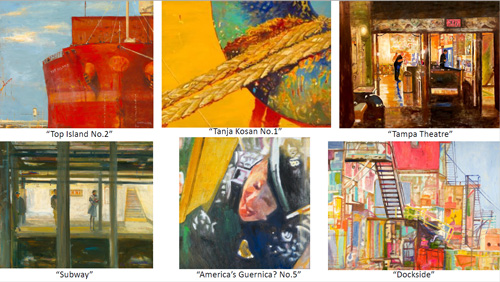
1) When did you start painting and was there a defining moment when you decided to pursue your passion?
I have always loved art and art history. Art History classes at Tulane led to lifetime visits to art museums. While a financial planner, I would attend watercolor five-day workshops as a reprieve from the stresses of the stock market. Then, having been diagnosed with breast cancer in 2005, I began thinking about life after financial planning and transitioning the practice to Jon. You see, one of the gifts of cancer is that it gives permission to redesign your life. When I left the practice in 2012, I began intensive studies one on one with an oil painter whose work I admired. And as a Type A, I knew I’d need a schedule, workspace, and gallerists to work with. Maine has provided that.
2) How does your life experience affect your work? Are there any similarities to your time as a financial planner?
All art is autobiographical. I have always been an observer of ways of life and of people as reflected in the careers I’ve chosen—clinical social worker, financial planner, and artist. I also adore what I call “ Drop-Ins” — books, movies, and art that drop you into a new world you knew nothing about. That’s what fascinates me about Port Tampa Bay and the massive working ships that go in and out of our waterways. I realized what a vital part the port plays in our economy, our demographics and our jobs. Yet living here, I hardly noticed the port.
3) Your collections—Working Waterfront, Urban Landscapes and Urban interiors—highlight commercial shops, busy city streets, and subways. What do you see in these types of settings that drive your curiosity/inspiration? What do you hope viewers see from observing your paintings?
There is a Japanese concept called “Wabi Sabi” that I interpret to mean there is beauty in the ordinary. There is beauty all around us. If we can learn to see, really see, then the world opens up to us. The Ashcan Artists painted ordinary life and attracted a huge audience because I believe it felt familiar. If I can paint a gritty wall in the port covered with decades of rust and grime and make it almost appear as an abstract painting, then I am pleased.
4) How has your style changed over time?
Sometimes my work seems more abstract; sometimes more representational. I paint larger when doing the ships probably because they are massive and it is easier to portray that on a large canvas. Perhaps I’m using color more and I’m not afraid of exaggerating color for effect.
5) Describe your dream project.
A breakthrough for me in my art was when an instructor emphasized the need to paint what you see, not what you think you see. In some ways that could be said of gaslighting. What you see is your actual vision. Gaslighting in today’s world tries to tell you something other than what you saw. I painted a series called “America’s Guernica?”. I painted from television photos taken during the events of January 6th. Accurate paintings of the actual events. No gaslighting. What your eyes see.
6) What are you currently working on?
Working Waterfront paintings to be in a solo exhibition at Moss Galleries in Portland, Maine in late spring 2022.
7) Do you have any advice for someone that wants to start painting but doesn’t know where to start?
First of all, never say I can’t, I have no talent. Nonsense. Painting can and is taught. There are great workshops at the Tampa Museum of Art, Morean Center, Dunedin Fine Arts Center, Tampa Regional Artist Center etc. Here in Maine where I spend part of the year, Coastal Maine Art Workshops have great instructors.
Grab a sketchbook, a brush, a pen and a box of watercolors and sketch wherever you go. You’ll really see life around you.
8) Is there anything you would like to say to your former Waller & Wax clients?
Yes! I miss you and your families. As you get closer to your own retirement, develop other interests — whether it is art, philanthropy, tutoring, photography, whatever. It could give you a new life after retirement.
There are some old truisms that bear repeating:
Always live below your means.
Pay yourself first by saving a portion of any money that comes your way.
Retirement saving plans are sacred and for retirement.
And most important, keep you and your family safe during this pandemic.
All my best,
– Laura
July 12, 2021 | National Association of Women Artists, Inc.

Welcome to our feature “Face to Face,” via the NAWA (Official) Members Group, which features a new interview with a NAWA artist every Monday. Check it out for fascinating insight on their practice, their artistic vision, their personal history, and much more!
This week we are pleased to introduce Laura Waller Art as our featured artist.
NAWA: Laura, please tell us where you live.
Laura: We live half the year in Tampa, Florida and half the year in Rockland, Maine. I maintain a studio in both cities. My studio dog Teddi, a miniature Australian labradoodle, rules as I paint with classical music in my earbuds. My seagull Zelda waits on my roof in Maine for her breakfast to be served on the porch.
NAWA: What type of art do you create?
Laura: My work is representational in nature. Some have described it as documentary art, I am currently working on two series — “The Working Waterfront” and “America’s Guernica?” about January 6, 2021. I paint with water-mixable oils made by Winsor and Newton Artisan, Holbein Duo and Talens Cobra.
NAWA: Tell us a little about your process.
Laura: I work from photographs I have taken on site. For the Port series that can mean accompanying a harbor pilot (female) while she takes a 500-foot ship from the docks out to sea or sitting behind the tugboat captain in the wheelhouse while he pushes a container ship to its berth in the port. I then paint from the photographs in my studio.
NAWA: That is so awesome! Are you a full-time artist? If not, what is your other career?
Laura: After earlier careers as a clinical social worker and then as the owner of a financial planning firm, I became a full-time oil painter in 2012. Prior to that, I painted watercolors during workshops I attended as necessary respites from the stresses of the stock market.
NAWA: Does your art have an overarching theme or a message?
Laura: I want people to see, really see the world around them. I have focused on the working port as most of us were unaware of the importance of this industry to our lifestyles until the Pandemic made apparent the vital role of shipping to the world’s supply chain. Shipping goods reached emergency status with delayed orders, shelves emptied of essential household goods, and a decreased work force all combined to nearly bring international commerce to its knees.
NAWA: Your images are truly captivating and draw the viewer in to take in your subject. How do you decide what to make the focal point?
Laura: I believe a painting should be made up of many abstract paintings. If you make a viewfinder with your hands and move around one of my works, multiple abstractions appear. This is why I usually don’t follow the rule of having a center of interest. I want there to be interest in all of the painting so you will choose to stay awhile and never tire of returning.
NAWA: I really like that! Is there someone who has made a significant impact on your art? A mentor, fellow artist, etc…
Laura: Charles Reid taught me to paint what I see, not what I think I see.
Tina Ingraham taught me the joy of oil painting. The Ashcan Artists encourage me to paint the everyday world. Hilma af Klint and Carmen Herrera help me understand that good can come to those who wait.
NAWA: That last one is something we can all learn from. Do you have any upcoming shows?
Laura: I have two upcoming shows in Maine — a solo exhibition of the Working Port Series at Elizabeth Moss Galleries and a group show called Circle of Friends at Salt Pond Studios.
NAWA: Kudos on your group show, and special congratulations on your solo show! Thank you so much for taking the time to share some of your inspiration and thoughts behind your art. Do you have a favorite quote you’d like to share with us?
Laura: Here are some of my favorite quotes:
“You are an artist when you say you are. And you are a good artist when you make somebody else experience or feel something deep or unexpected.”
– Amanda Palmer
“What any true painting touches is an absence — an absence of which without the painting we might be unaware. And that would be our loss.”
– John Berger
“The creative adult is the child who has survived.”
– Ursula LeGuin
“Every strike brings me closer to the next home run.”
– Babe Ruth
Laura Waller’s art is in the collections of the Tampa Bay History Museum, the Strand Theater, American Victory Museum, Raymond James Financial, Eli Lily Company, and Rockland Public Library.
You can also see more of Laura’s art at the following links:
LauraWallerArt.com
instagram.com/laurawallerart
facebook.com/Laura-Waller-Art-274100203356
ElizabethMossGalleries.com/laura-waller
Fall 2020, Member Submissions, UMVA Members Showcase


I feel out of it. Everything is touched by this Pandemic but most of all, I feel out of it without people. And so, I paint what I miss.

First, I painted friends and relatives as large faces that captured the essence of each person in their eyes and mouths which is how I feel we communicate. Gradually my studio filled with friendly faces and I was not alone. This series premieres at Elizabeth Moss Galleries September 26th.

Then I began two series that reflected the activities I missed most – gathering at art museums and eating out with those I love. The former gave me an added gift as I got to paint in the manner of favored artists in museums.
The Eating Out series evokes the joy when out with a group of friends in a convivial restaurant setting. For me the best of dinners feels like a Mad Hatter’s Tea Party.

Painting puts me in touch with what I miss during the Pandemic— literally.


Initially anxious, unmotivated, and disoriented, this time has opened possibilities I could never have imagined. Isolating at home with few distractions has given me the time to focus on my art in a new way. I am nourished by nature, my garden and my heightened awareness in the moment.


As I continue to work as a psychotherapist from home, I think my recent artwork reflects the roller coaster of inner peace entwined with worry about loved ones and the world.
Eva Rose Goetz
“Greetings from the New World”: Painting within a pandemic
In March, asked to socially isolate and wash our hands, I began journaling the pandemic through paintings. The world had stopped and all of us were experiencing and wondering what may greet us, together, isolated within the pandemic. This series was to visually report, reflect, and transcend the hurt and confusion playing out within the collective and myself; a coping mechanism.

As I painted, many died from the virus. COVID-19 brought into sharp focus unsustainable practices hidden within the folds of affluence and unjust health care policies. The murder of George Floyd proclaimed brutal police policies, coupled with racism, are undeniably alive and running through America’s veins. As the availability of water and space to distance became understood as necessary, the virus rebranded homelessness and the incarcerated as a “social health crisis.” Essential workers were revealed as the heroes they always have been, providing services necessary for our survival, with health care workers the superheroes, tirelessly caring for us.

Called to witness and absorb, I painted about it all.


I still paint. This story is not done.
June 4, 2020 | By Jennifer Ring | creativepinellas.org
Laura Waller, known for her Port of Tampa series, recently embarked on a new project. Waller’s Museo series takes us somewhere many of us haven’t been in months – art museums.
“I’ve always been a person who loves museums,” says Waller. “My husband and I, whenever we go someplace, whether it’s in the country or out of the country, we always gravitate to their art museums. It’s a way of learning about the country through someone else’s art.”
As we neared the end of Florida’s stay-at-home orders, Waller asked herself what she missed the most. “I miss restaurants because that’s where I met all my friends,” says Waller, “The other thing I really miss is having contact with people, or even with other artists, alive or deceased, through art museums.”
So she started going through photos and found some of her most recent favorite museum moments. “That’s where the impetus [for the Museo series] came from,” says Waller, “beginning to step out from coronavirus isolation into a space that I’ve always enjoyed more than most other places.”
Waller launched the series with a painting of Lesley Dill’s Red Ecstasy Dress from the Museum of Fine Art’s Art of the Stage exhibit. The MFA, Waller tells me, holds a special place in her heart for many reasons.
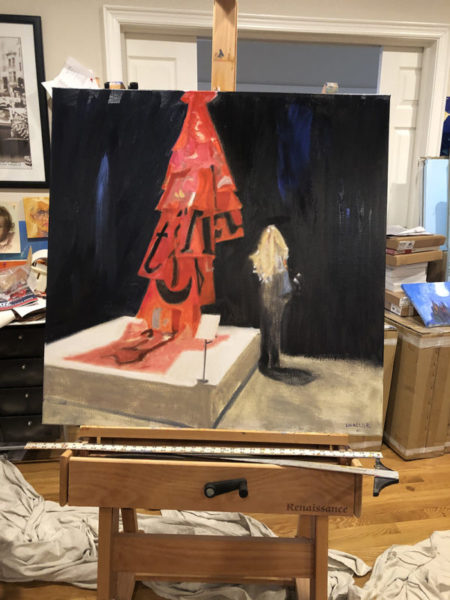
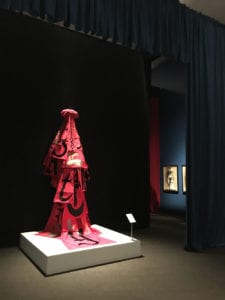
Red Ecstasy Dress by Leslie Dill – Museum of Fine Arts, Art of the Stage exhibit, photo by Jennifer Ring
When her granddaughter was much younger, Waller used to take her to the MFA every Saturday. “They had what I called a hunt, where they would give a picture of one of the paintings in the museum and turn [the kids] loose to find it.” Waller remembers the one time her granddaughter was handed a copy of Georgia O’Keefe’s Poppy. After the kids found the painting, Waller tells me “they had to sit down on the floor and draw it and paint it.” This way, they really got to know that painting.
Another time, when Waller visited the MFA with friends, she chanced upon an engineering class from Florida Technical College. “The professor, as part of his curriculum, takes his class to the museum, puts two people at a time in chairs in front of a single painting, and makes them sit there for 45 minutes to an hour without speaking,” says Waller. “At the end of that time, they’re allowed to talk.” Like the hunt, this exercise forces students to really look at a work of art and consider what it means to them.
“Once you really study a painting,” says Waller, “it’s like running into an old friend whenever you see it again.” Museums provide the stage for that focused study to happen.
“We’re not able to go into galleries as much as we used to,” Waller tells me. “The whole world is changing right now, and it’ll be interesting to see how it all works out. Even though you can look at a piece of art over the internet, it still won’t be the same experience as walking into an art gallery and falling in love with a piece of art, or walking into a museum and falling in love with a painting before you.”
Museums, like so many of Waller’s favorite subjects, are a world unto themselves. They’re a special place, free of distractions, where you can truly get lost in someone else’s art.
“We can’t afford to lose museums,” says Waller. “We can’t afford to lose the galleries.”
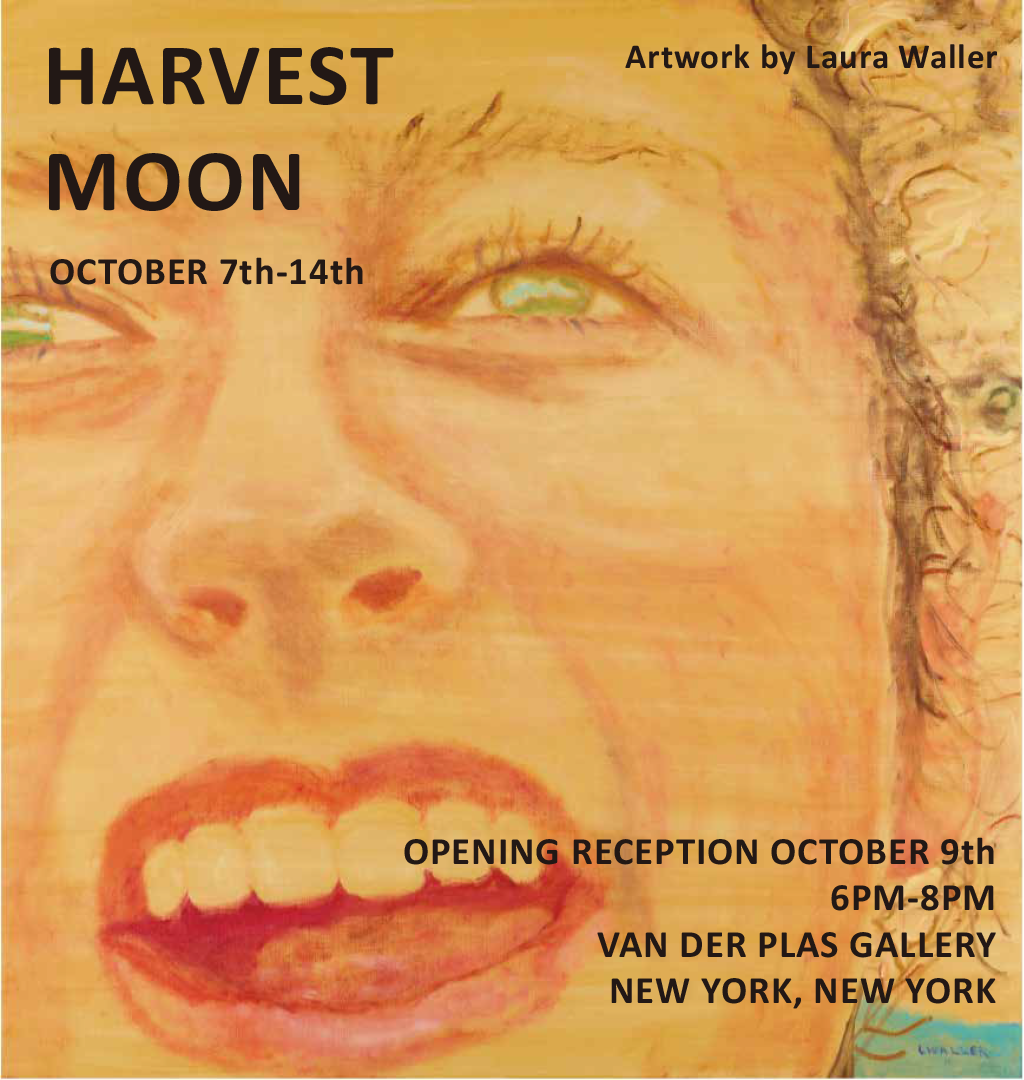
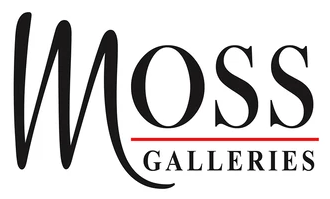
Last week we hosted the opening reception for Laura Waller: Bright Lights, Big City. It was a great evening and it is always a pleasure showing the work of Laura Waller. If you weren’t able to make it to the reception, we hope you will be able to make it into the gallery to see her paintings before the show closes on October 5th. We were able to present Laura with some questions about her work and the exhibit and we are happy to be able to share her answers with you today.
Your upcoming exhibit at the gallery is entitled Bright Lights, Big City. Can you tell us a bit about the show and what inspired you to create these pieces?
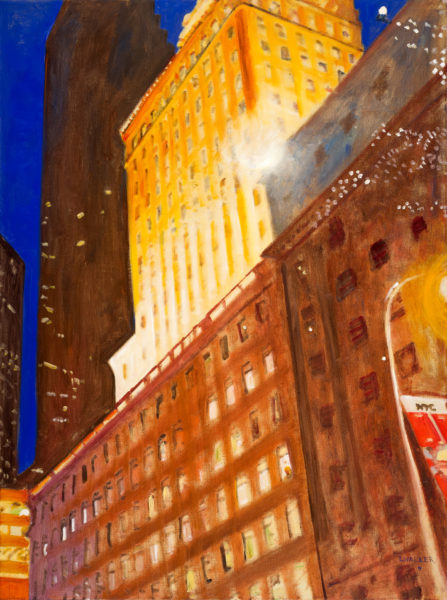
All art is autobiographical. I have been painting bright lights and big city places that are part of my DNA from NYC where I was born, to Tampa where I have lived the longest, to New Orleans where I got my undergraduate and graduate degrees to Rockland where I feel I flourish.
I have returned to NYC almost every year of my life and feel it is the quintessential city of America. Probably the 9/11 terrorists recognized this when they chose their target. At night, the city is aglow with neon and headlights through which the people dash. But, as in my painting titled NYC Abstracted No. 2, it can be the loneliest place in the midst of the crowds. In this painting, there is only one person in the window.
Some of the paintings in the show depict the interiors of the theaters. What was your process for creating these paintings?
I am fascinated by places that are worlds unto themselves. There is that encapsulated warm feeling one gets when you enter a brightly lit theater on a cold night. Shubert Theater No. 2 evokes that mood.
Lately, I have been focusing on the 1920s-1930s built theaters that dot our country and miraculously have been preserved and restored. The Strand in Rockland and the Tampa Theatre are examples of these classic architectural gems. I am lucky to live near both. They are a direct contrast to the cookie-cutter nature of our neighborhood multiplex cinemas. They welcome you by their elaborate settings from a slower time. Tampa Theatre brings you into a small Mediterranean village at night with stars above your head and white doves resting on ornately carved walls of muses and patterned plaster. After the event, you walk by a brightly lit concession stand in the lobby surrounded by tapestries, majestic stairs and Spanish tiles below your feet. You linger. Tampa Theatre: Concession Stand and The Strand Theater.
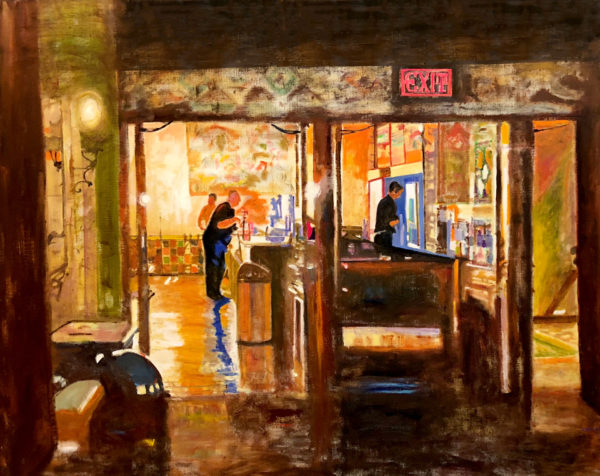

What about the I am Woman pieces? Can you give some background on these paintings?
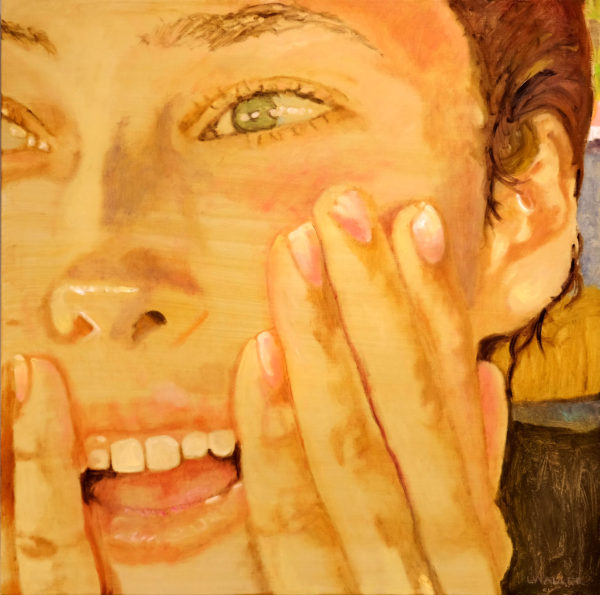
I paint what I can’t say. For the recent past, I have been speechless as I watch what has been happening in how we as a country treat our citizens. I am very concerned about the return of misogyny in this era— from denigrating women and their looks to the somewhat misogynistic question even my female friends are repeating about the upcoming election — but is she electable?
And so I began celebrating women by painting them close up and uncontained by the canvas — perhaps a metaphor for how women should not be bound by outdated restraints.
You divide your time between studios here in Maine and in Florida. Does your work differ much from studio to studio?
This year for the first time I have a studio outside my home at Lincoln Street Center in Rockland. Bottom line, I am more productive. There are no distractions, and I’m on a schedule to work (as I was as a businesswoman for 35 years). I have a dedicated space to work, to explore, and to reach. I can also share thoughts with other artists by opening my door.
Thank you so much to the artist, Laura Waller, for sharing some insight into her life and work. Please visit our website for more information about the exhibit and her available paintings.